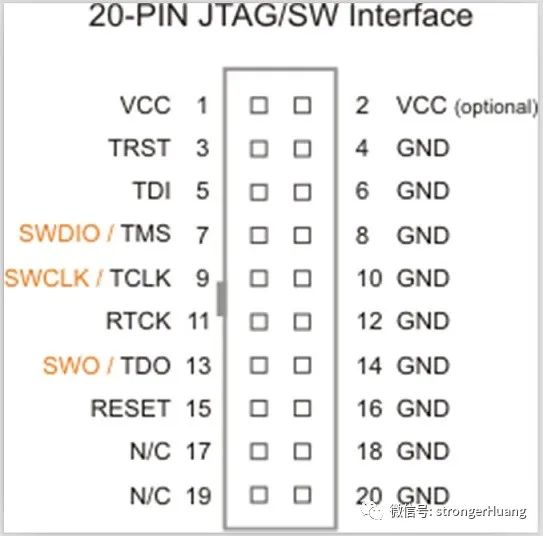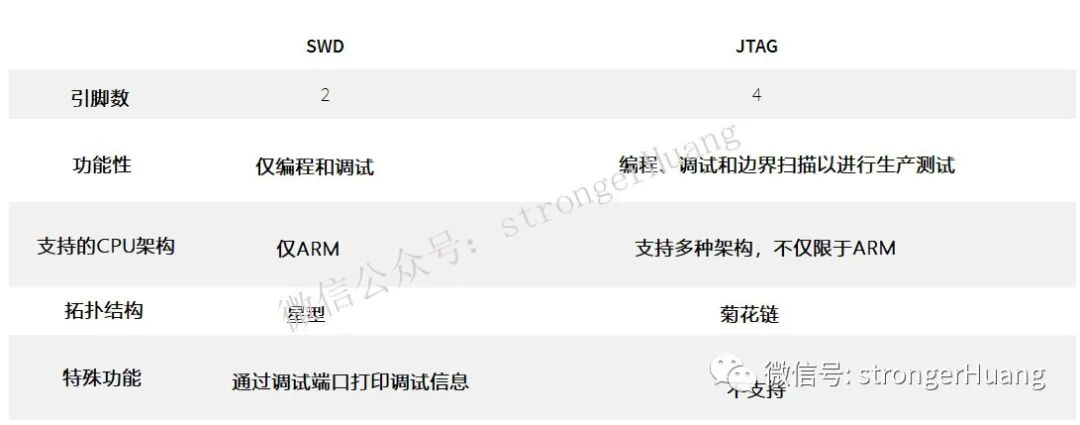As an embedded engineer, you should know about download debuggers, but do you really understand the meaning and differences between the SWD and JTAG interfaces?
What is a Download Debugger
In simple terms, a download debugger is a device that converts commands sent from a PC (for example, via USB protocol) into a language that the MCU (which manages the internal peripherals of the MCU) understands (such as SWD or JTAG protocol), loading code and precisely controlling execution.
Debugger Protocol Standards
In simple terms, a standard is a set of rules and protocols that every participant in a specific industry agrees to follow and implement.
2. The Chaos of Debugger Protocols
Before protocols like SWD and JTAG emerged, debuggers and their protocols were chaotic, with each MCU manufacturer proposing their own proprietary methods to load code onto their MCUs.
Every time a manufacturer released a new MCU, embedded software engineers had to understand its proprietary protocol to load code onto the microcontroller.
Moreover, debugging adapters were expensive because manufacturers didn’t have competitors that could make debugging adapters compatible with their proprietary protocols.
Another reason for their high cost was due to their limited availability, as they could only sell debugging adapters to companies (engineers) using the MCUs they produced.
Different protocols also led to increased development costs. For example, if you have four different chips from four different manufacturers on your designed board and wish to conduct some automated testing to improve the efficiency of the production process.
However, since all the circuit boards have their own protocols, you need to create a super complex production code that can adapt to the complexity, and you need to install four different debuggers at the test points on the circuit board, which increases costs, production time, and programming time.
3. Establishing Protocols
Various download debugging differences can lead to several issues:
-
Investing more learning time
-
Increasing the cost of purchasing download debugging tools
-
Generating inefficient testing
To address this issue, engineers from major MCU manufacturers and producers have established some standardized protocols for debugging.
JTAG:Joint Test Action Group, which began discussions in the late 1980s and officially released documentation interpreting the IEEE standard in 1990.
IEEE stands for the Institute of Electrical and Electronics Engineers, an international organization that publishes all standards, such as WiFi, Bluetooth, etc.
The protocol they proposed was recorded in IEEE 1149.1 in 1990, and the document has been revised and improved. As of the writing of this article, the latest standard is IEEE 1149.7.
JTAG essentially has 5 pins:
-
TDI: Test Data In, the serial input pin
-
TDO: Test Data Out, the serial output pin
-
TCK: Test Clock, the clock pin
-
TMS: Test Mode Select, the mode selection/control signal pin
-
TRST: Test Reset, the reset pin
SWD:Serial Wire Debug, a protocol designed by ARM for programming and debugging its microcontrollers.
Since SWD is specifically focused on programming and debugging, it has many special features that are usually unavailable elsewhere, such as sending debugging information to a computer via IO lines.
Additionally, because it was manufactured specifically for use in ARM devices, the performance of SWD is often the best among its peers!
SWD Pins:
-
SWDIO: Serial Wire Data Input Output, the serial data input/output pin
-
SWCLK: Serial Wire Clock, the serial wire clock pin
Various Differences Between SWD and JTAG
There are many MCUs and debugging adapters on the market that are compatible with both SWD and JTAG protocols, typically implementing download and debugging functions through a set of download debugging pins that are internally multiplexed to SWD and JTAG peripherals.
The pins of SWD can be multiplexed with JTAG pins under certain conditions. Currently, there are many connectors for JTAG and SWD, such as the 20-pin connector:
Of course, there are also 10-pin connectors:
2. Advantages of SWD and JTAG
Advantages of SWD Protocol:
-
Uses fewer pins, requiring only SWDIO and SWCLK
-
SWD has special functions, such as printing debugging information through its I/O lines
-
SWD has better overall performance in terms of speed compared to JTAG
Advantages of JTAG Protocol:
-
JTAG is not limited to ARM chips; it also supports chips outside of ARM, such as the familiar MSP430
-
JTAG has more versatile uses for programming, debugging, and production testing
-
JTAG is an independent group that evolves with the development of the protocol
3. When to Choose SWD Over JTAG
-
If your schematic/circuit board design is simple enough to test without JTAG functionality
-
Debugging performance is more important than production testing, and your device focuses on research rather than mass production!
-
If the MCU has size limitations, SWD can save space
-
If your hardware design is too complex, and the MCU has no extra 2 pins
Conclusion: SWD / JTAG Comparison
Below is a summary in a diagram:
# Welcome to Leave a Message #
The reader with the highest number of likes in the comments will receive a free shipping gift of a simple advertising light kit, with the deadline being January 29 (Friday) at 3:00 PM. The winner must add the editor’s WeChat (Huang-Y2120) on January 29 to claim the prize. Late entries will be void, and each ID can claim it for free once every two weeks.






